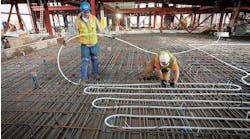Latest from Management
Sponsored
My first experiment with alternative radiant heating surfaces was a radiant wall project. I was asked to become involved in a special Habitat for Humanity project, and the endeavor had the participation of the Department of Energy’s National Renewable Energy Laboratory (NREL). The department wanted to build one of the most efficient homes not only in the history of this particular Colorado chapter of Habitat for Humanity, but the U.S. as well.
During one of our first planning meetings, we met with the staff architect, NREL staff employees, and representatives of the local chapter of the old RPA. After introductions, we offered to provide all parts and labor necessary for a radiant floor heating system. The representative from NREL said, “Nah, everyone is going radiant floors …” I replied that we would be glad to do radiant ceilings, to which he replied, “Nah, radiant ceilings have been around longer than radiant floors have been around …” This guy was obviously well prepared and had done his homework long before coming to this meeting.
I said that we were quickly running out of alternatives and the only other surface that was feasible to do was the walls, to which he replied, “BINGO!! We want to do a radiant wall heating system for this home.” Having never done a radiant wall heating system before caused me a little concern, but knowing that I had the backing of the oldest PEX tube extruder at my beck and call provided me with a feeling of comfort. I responded in the positive, and the process began. I immediately began thinking of all the things that could go wrong, because these homes are essentially built with volunteer labor.
The first thing we did was to perform a detailed heat-loss calculation on the proposed structure. The heat-loss calculation numbers came in at a relatively low value per square foot per hour, so the net wall output area was very much within reason. My support staff recommended that we utilize aluminum heat transmission plates in our design in order to maximize the overall system efficiency. Our heat source for this system was a modulating condensing boiler manufactured by Heat Transfer Products. The lower we could keep our operating temperatures, the better the heat source would operate, efficiency wise.
The next thought process had to do with the potential of having a nail inadvertently driven into one of our tubes, either during or after construction. We decided that in order to keep this from happening, we would keep the heat-emitting surfaces below the normal picture hanging height. Essentially, we kept everything within 48 inches of the finished floor. This didn’t preclude the possibility of a child hitting the tube while hanging some artwork, but I’ve never seen a child use a hammer and nail to hang water color drawings, so I didn’t lose any sleep over it. I did have some thoughts — and nightmares — about volunteer sheet rock hangers with wild looks in their eyes and cordless screw guns in their hands, but thought I’d cross that bridge when I got to it.
As the construction process began, we had to assure the local authority having jurisdiction (AHJ) that the design we were using was “approved” by the tubing manufacturer (then the WIRSBO company), who graciously walked the AHJ through the process. The AHJ was not familiar with radiant wall heating and was concerned about potential missteps in such a high-profile project.
We decided that instead of furring out the walls to accept the heat transmission plates, we would route grooves into the framing members to allow the heat transmission plates to have full surface contact with the sheet rock that would eventually be applied to the finished wall. We developed a “template” that would allow us to perform the grooving at the necessary depth and proper centers (8” on center). After grooving was completed, we installed the light aluminum heat transmission plates into the face of the wall, installed and secured the tubing, and completed the rest of the distribution system. To ensure proper insulation, we installed our own fiberglass insulation into the cavity of the radiant walls. In one particular case, we had radiant walls on both sides of a partition wall between a living space and a sleeping space, and the insulation basically guaranteed that we would have complete zone control over the two individual zones with minimal back loss or inadvertent gains to the adjoining rooms. Most people wouldn’t even consider placing insulation behind the panel when the panel is within the heated space, and that would be a critical error. We must control the directional flow of energy as it is leaving the panel and directed to the conditioned space.
Tune in next month as we continue looking at alternative radiant heating surfaces in our efforts to “Grow Radiant.” If you have not yet become a member of the new RPA, by all means go to our website at www.radiantprofessionalsalliance.org and get signed up. It is an inexpensive way to support your industry.
All Mark Eatherton material on this website is protected by Copyright 2013. Any reuse of this material (print or electronic) must first have the expressed written permission of Mark Eatherton and CONTRACTOR Magazine. Please contact via email at: [email protected].
Mark Eatherton
Mark Eatherton material on this website is protected by Copyright 2017. Any reuse of this material (print or electronic) must first have the expressed written permission of Mark Eatherton and CONTRACTOR Magazine.

